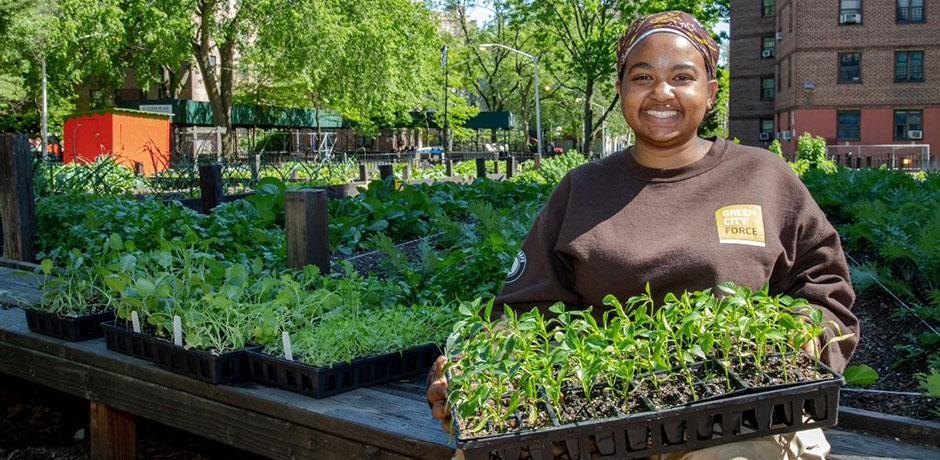How City Blooming can Save You Time, Stress, and Money.
How City Blooming can Save You Time, Stress, and Money.
Blog Article
City Blooming Can Be Fun For Everyone
Table of Contents6 Simple Techniques For City BloomingThe Ultimate Guide To City BloomingThe Buzz on City BloomingGetting The City Blooming To WorkNot known Details About City Blooming
Fascinated in expanding food offer for sale in the City of Chicago? Thinking about beginning a community garden? Changes to the Chicago Zoning Statute enable farming usages like area yards and metropolitan ranches in many components of the city. Below is a checklist of often asked inquiries pertaining to the rules and laws that cultivators need to think about when intending a city agriculture task.
The zoning amendment does not customize any various other codes taking care of composting, building authorizations, purchasing or renting City had residential or commercial property, organization licenses or environmental contamination. There are existing codes that regulate these problems and they continue to be completely result and may be appropriate to your job. Area gardens are generally possessed or managed by public entities, public companies or community-based companies and maintained by volunteers.
Urban ranches expand food that is planned to be offered, either on a not-for-profit or for-profit basis. Due to their commercial purpose, city farms need a company permit.
Some Known Facts About City Blooming.
Composting is enabled yet just for plant material that is produced and utilized on site. The quantity of garden compost material can not exceed 25 cubic lawns at any type of provided time according to the criteria in 7-28-715 of the City's Municipal Code. Yes. Due to the fact that the soil at many new yard sites needs modifying, garden compost, soil, wood chips, or various other materials can be acquired to create or enhance the growing area - garden care.

If a building permit is called for after that the hoophouse will certainly be taken into consideration an accessory building. You can locate out more about the structure permit demands by getting in touch with the Department of Buildings. The 25,000-square-foot dimension restriction is intended to stop a single community garden from dominating an offered block or detracting from the block's existing household or business character.
The limitation does not use to gardens situated in Public Open Room (POS) areas. Can there be more than one area yard that is 25,000 square feet on a single block? Fencing is not required, however, yards that have large car park locations may be called for to install fencing or various other landscape design functions.
City Blooming - Questions
B1 & B2 areas call for that all business usage activities be performed indoors. Is secure fencing needed for city farms? Fencings may be needed, along with landscape design and screening, for particular car parking areas and exterior job or storage areas depending on location and the details activity taking location.
Yes. Urban farms call for building licenses and zoning authorizations prior to construction. Other forms of city testimonial might be required relying on details structures, activities, dimension, landscape design, licensing, public health and stormwater monitoring concerns. A lot of these requirements are recognized in the task layout or permitting procedure, nevertheless, the applicant might be responsible to separately identify particular licenses or allows that might be needed.
The Department of Organization Affairs and Customer Defense can help figure out the particular kind of company license that's called for. Off road parking is required for a lot of commercial projects in Chicago. The called for number of car park rooms is based on the number of staff members working on site and not the square footage of the expanding space.
The Facts About City Blooming Revealed

A city farm can sell compost material created on website, nonetheless, the operation has to comply with the guidelines in 7-28-715 of the Chicago Municipal Code. Aquaponic systems are allowed indoors on urban farms in many zoning districts.
Up to 5 hives or nests of honey bees might be kept as an accessory use. Beekeepers must register with the Illinois Department of Farming. For more info regarding the recommended zoning modification you may contact the Division of Real Estate and Economic Growth, Bureau of Preparation and Zoning at 312.744.8563.
Farming in cities and urban locations A metropolitan farm in Chicago. Urban agriculture refers to different techniques of growing. https://www.behance.net/danielnold, handling, and dispersing food in metropolitan locations. The term also relates to the location activities of animal husbandry, aquaculture, beekeeping, and horticulture in a metropolitan context. Urban farming is identified from peri-urban farming, which happens in backwoods beside suburbs.
The Of City Blooming
, that seek to create social networks started on a common ethos of nature and community holism. These networks can establish by method of formal institutional support, coming to be integrated right into local town preparation as a "shift community" motion for lasting city growth.
The a lot more direct access to fresh vegetable, fruit, and meat items that may be realised through city agriculture can boost food protection and food safety and security while decreasing food miles, leading to reduced greenhouse gas emissions, thereby adding to environment adjustment mitigation. A few of the initial proof of urban farming originates from Mesopotamia.
Report this page